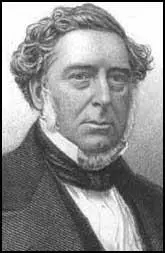Robert Stephenson

Robert Stephenson, the only son of George Stephenson, was born on 16th October, 1803. The following year the family moved to Killingworth where George became an enginewright at the local colliery. Robert's mother died of consumption at Killingworth in 1806.
Robert went to the local village school at Longbenton. George Stephenson's growing success as a locomotive engineer meant that he could afford to pay for Robert to have a private education. Between 1814 and 1819 Robert attended the Bruce Academy in Newcastle. Robert also became a member of the Newcastle Literary and Philosophical Society.
In 1819 Robert was apprenticed to Nicholas Wood, the manager of Killingworth Colliery. Three years later he joined his father to help him survey the Stockton & Darlington line. The following year Robert attended Edinburgh University where he met another student, George Bidder. The two men became close friends and were to work together on several different railway projects during the next twenty-five years.
In 1823 Robert Stephenson joined with George Stephenson and Edward Pease to form a company to make locomotives. The Robert Stephenson & Company, at Forth Street, Newcastle-upon-Tyne, became the world's first locomotive builder. To gain further experience, Robert went to South America in 1824 where he worked at gold and silver mines. While in Columbia he met the inventor, Richard Trevithick, and provided the funds that he needed to get back to Britain.
After three years in South America, Stephenson was recalled to England and began work on the Rocket locomotive. Robert's abilities as an engineer was illustrated by the success of the Rocket at the Rainhill Trials in October, 1829. During this period Robert and George Stephenson were kept busy producing locomotives for the Bolton & Leigh Railway and the Liverpool & Manchester Railway. This included locomotives such as the Northumbrian and the Lancashire Witch.
In 1833 Robert Stephenson was appointed chief engineer of the London & Birmingham line. This was the first railway into London and involved solving difficult engineering problems such as the Blisworth Cutting and the Kilsby Tunnel.
The London & Birmingham line was completed in 1838. For the next few years Stephenson was involved in constructing railways all over the world. He also built bridges, including those that crossed the Tyne at Newcastle and the Menai Straits. The Britannia Bridge at Conwy was made up of two huge, rectangular, wrought iron tubes. Stephenson constructed a similar bridge over the St. Lawrence River at Montreal, Canada (1854-59). For many years, this was the longest bridge in the world.
In the 1847 General Election Stephenson was elected as the Conservative MP for Whitby. Stephenson did not take an active role in the House of Commons and usually only contributed to debates on engineering issues.
Stephenson never enjoyed good health and early in 1859 he was advised to retire from business and politics. He took a yachting cruise but when he arrived in Norway his condition deteriorated and he was rushed back to England.
Robert Stephenson died on 12th October, 1859.
Primary Sources
(1) Samuel Smiles, Life of George Stephenson (1875)
Robert Stephenson went to Mr. Bruce's school in Percy Street, Newcastle, in 1815, when he was about twelve years old. His father bought him a donkey, on which he rode into Newcastle and back daily. When Richard went to school he was a shy, unpolished country lad, speaking the broad dialect of the pitman; and the other boys would tease him. As a scholar he was steady and diligent, and his master was accustomed to hold him up to the laggards of the school as an example of good conduct and industry.
(2) When Robert Stephenson wrote William James when he heard about his financial problems (August, 1823)
It gives rise to feelings of true regret when I reflect on your situation; but yet a consolation springs up when I consider your preserving spirit will for ever bear you up in the arms of triumph, instances of which I have witnessed of too forcible a character to be easily effaced from my memory.
(3) Samuel Smiles, a close friend of Robert Stephenson, became concerned about his poor health.
He was habitually careless of his health, and perhaps he indulged in narcotics to a prejudicial extent. Hence he often became ill. When Mr. Sopwith succeeded in persuading Mr. Stephenson to limit his indulgence in cigars and stimulants, the consequence was that by the end of the voyage he felt himself, as he said, "quite a new man". But he was of a facile, social disposition and the old associations proved too strong for him.
4) F. R. Condor, an engineer on the London & Birmingham Railway, wrote about Robert Stephenson after his death in 1859.
Robert Stephenson, in those days, almost lived on the line. In the earlier days he charmed all who came in contact with him. Kind and considerate to his subordinates, he was not without occasional outbursts of fierce northern passion. During the whole construction of the London and Brighton line, his anxiety was so great as to lead him to very frequent recourse to the fatal aid of calomel. There can be little doubt that his early and lamented death was hastened by this ill-considered devotion to the service of his employers, and the establishment of his own fame.
